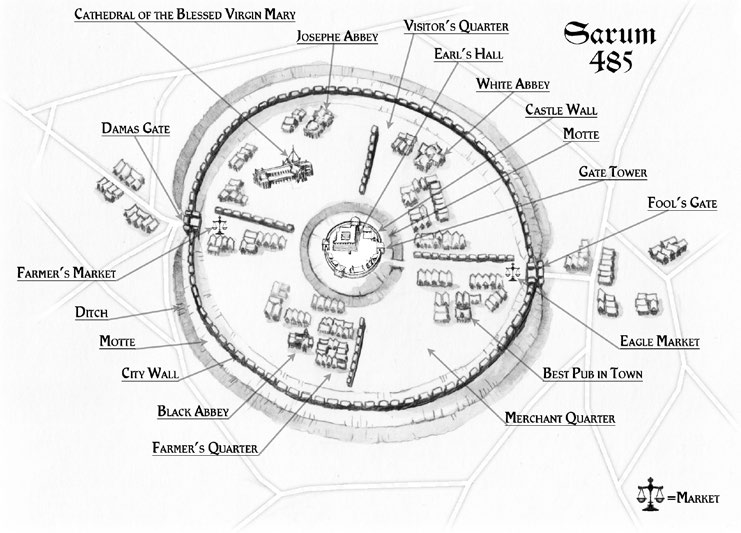Sarum was first settled centuries ago during the time before iron was used, in the days when people still worshipped the sun at Stonehenge. A series of concentric rings surround the city: a massive ditch on the outside, then a huge rampart, then another
large ditch and another rampart.
A great curtain wall perches on the inner rampart and overlooks the inner ditch. The wall is 12 feet thick and 40 feet high. Battlements give its top a serrated shape, made by merlons (the upright stone) and crenellations (the breaks or indentations between
the merlons).
Two gates, to the east and west, pierce the walls. They are defended by towered gateworks, each with its huge iron-reinforced portcullis, murder holes, and drawbridges. As with all cities, these are closed at night and normally admit no one.
In the center of the city is a great motte, or artificial mound, upon which sits the large castle of the earl. Four ditch-and-rampart spokes radiate from the castle almost to the outer wall, and divide the city into quarters. The northwestern quarter is given over to the magnificent cathedral and church buildings, a part of the fief of the Bishop of Salisbury. It is occupied by churchmen and the bishop’s retinue. The cathedral is dedicated to Saint Mary, the Mother of God.
The city occupies the rest, and it serves as the outer bailey for the castle. It is large and relatively rich. It serves as the trading center for the entire county and the earl receives rich revenues from its taxes, part of which go to the king. A royal mint here stamps out silver pennies that show King Uther’s image on one side and the name of mint and minter on the other. The earl receives no income from this source.


History
The first inhabitants here were the giants, long before any people came here. Ancient earth beings — faerie folk and their ilk — were always residents since they are a part of nature.
When Brutus came to Britain, he and his legions destroyed the giants and took the land. Salis was a brave warrior in the Trojan army. When the island was partitioned, Brutus gave Salis a vast area for his own. While Brutus was busy building London, Salis went to his land and killed the local giant here, and then threw the bones to the giant’s own dogs.
Salis freed hundreds of slaves of the giant, and their queen was named Sarum. She was the daughter of a great queen who lived inside a hill up the Avon River — Silbury Hill. Salis married Sarum, and the people built a city to celebrate their marriage. Salis named it after his wife, and it is still called Sarum to this day. She divided the city into five parts, one each for the druids, the merchants, the farmers, the visitors, and, in the center, the nobles. Her younger son, the one who did not become earl, built the walls that divide the city into quarters.
When Salis died, he was buried far outside the city under a mound, and that is why the plains are called Salisbury. His nobles adopted the same customs and were also buried there, and the area became famous as a burial ground for a long time. Out there now are still thousands of tombs of all types, including the Royal Graveyard of Stonehenge said to have been raised by Merlin himself.
King Eburacus, who performed many great deeds, later ruled Britain. (He lived a about the time of King David’s rule in Judea.) His son Assaracus led eighteen bands of Britons to the continent and conquered the people there. They became powerful and included many tribes who, collectively, called themselves the Belgae.
About the time of Romulus and Remus, when Rome was founded, Britain was ruled by King Lear. When he went mad, the fool who tended to him came from Sarum. The king was sheltered here. Afterward, his daughter Queen Cordelia rewarded the city by having a castle built for the nobles.
Much later, Dovulus, the son of Earl Dalogmius of Sarum, was the first warrior over the walls when the Britons sacked Rome. King Belinus rewarded him with the Eagle Statue that is in the market square.
Later, Velanus was a powerful king among the Belgae on the continent. He came to the island to hear the music of King Beldgabred and in the end married one of the king’s daughters. When his brother-in-law — the heir to Beldgabred — died, war broke out over the succession. Velanus was instrumental in helping noble Eldol to become king. As a result, Eldol gave Velanus lands to rule. Later, many of the Belgae from the continent came to live in his lands that are today called
Hampshire, Salisbury, Clarence, and Gloucester.
The Belgae here fought fiercely against the Romans, but were eventually defeated. The Romans established a military camp in the city of Sarum, taking over the Visitor’s Quarter and laying out Roman buildings there. They also took over the fort, of course, as a barracks and headquarters.
The first Christians here were monks who established the Abbey of Saint Josephe (son of Joseph of Arimathea, and first Bishop of Britain.) When the black monks came, and later the white monks, they too got space for their abbeys. The old church has been rebuilt and is now the cathedral, overseen by a bishop of the British Church. Despite the presence of these, pagans still populate the countryside, including many knightly manors.
